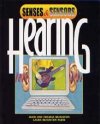Sounds and Silence Additional Information
The National Park Service describes its natural soundscape program at www.nature.nps.gov/naturalsounds/index.htm (National Park Service).
The Nature Sounds Society, which is dedicated to the preservation, appreciation, and creative use of natural sounds, has a Web site at www.naturesounds.org/.
You can learn more about sounds and the soundscape project at Biscayne National Park in Florida at www.nps.gov/bisc/sound.htm.
You can find out more about the radio program “Pulse of the Planet” and hear some excerpts at www.pulseplanet.com/.
The World Soundscape Project is described at www.sfu.ca/~truax/wsp.html.
Peterson, Ivars. 1996. Sounds of the seasons. Science News 150(Dec. 21&28):400-401. Available at http://www.sciencenews.org/sn_arch/12_21_96/bob2.htm.
Valuing the soundscape: A new aspect of public lands management
www.acousticecology.org/wildlandsoundresource.html
Acoustic Ecology Institute
Books recommended by SearchIt!Science:
 |
Secrets of Sound: Studying the Calls and Songs of Whales,
Elephants, and Birds — April Pulley Sayre
Published by Houghton Mifflin Co., 2002.
Off the coast of Hawaii, Christopher Clark is using underwater microphones to listen in on the songs of whales. In the rain forests of Africa, Katy Payne is recoding elephant sounds that are beyond the range of normal human hearing. And Bill Evans works in the North American plains to study the calls of night-migrating birds. These scientists are bioacousticians—scientists who study animal communication—and this book will introduce you to the field of bioacoustics, the projects these scientists work on, and the ways they work to conserve our planet’s wildlife. |
 |
Hearing — Alvin Silverstein, Virginia Silverstein, Laura Silverstein Nunn
Published by Twenty-First Century Books/Millbrook Press, 2001.
Everything we know about the world around us is based on messages that we receive from our five senses. Sound travels through gases, liquids, and solids. Learn how the human ear acts as a sound-gathering device. Some animals have developed the ability to catch their food at night by sending sounds that bounce off objects and return to their ears. Find out about how the brain “hears” sound. How do you hear what you hear? Researches have developed digital hearing aids that can help people with different types of hearing loss. |
Power Words
acoustics The scientific study of sound and how it travels.
sound A type of energy that travels as waves and can often be detected by the ears. Sound starts out as a vibration of something, such as a guitar string. The vibration causes sound waves to move through another substance, such as air, water, or a piece of wood. Sound waves move through air at a speed of about 1,070 feet (326 meters) per second.
Sound is measured in decibels. A normal conversation has a loudness of about 60 decibels, and thunder at very close range has a loudness of about 140 decibels. Sound greater than 85 decibels can cause damage to the ear, and sound with intensity above 120 decibels can cause pain.
sound wave A kind of wave that moves as changes in pressure and density through a substance and carries sound. How loud a sound is depends on the amplitude of the sound wave. How high a sound is depends on its frequency.
Copyright © 2002, 2003 Houghton-Mifflin Company. All rights reserved. Used with permission.
